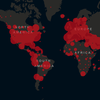
The COVID-19 dashboard developed by the Johns Hopkins Centre for Units Science and Engineering is shown for the duration of a briefing on Capitol Hill in early March 2020, when only 245 verified scenarios experienced been noted in the U.S.
Samuel Corum/Getty Illustrations or photos
cover caption
toggle caption
Samuel Corum/Getty Photographs

The COVID-19 dashboard established by the Johns Hopkins Middle for Systems Science and Engineering is displayed during a briefing on Capitol Hill in early March 2020, when only 245 verified instances experienced been claimed in the U.S.
Samuel Corum/Getty Pictures
In yet another signal of the transforming condition of the pandemic, an a must have source of facts about the virus in excess of the final a few years is shutting down, NPR has learned.
The Johns Hopkins Coronavirus Useful resource Middle ideas to stop operations March 10, officers advised NPR.
“It can be bittersweet,” says Lauren Gardner, an engineering professor who released the undertaking with one particular of her pupils on March 3, 2020. “But it’s an ideal time to move on.”
When the pandemic erupted, no one understood a great deal of just about anything about the virus and how to react. Was it protected to go grocery purchasing? How conveniently could someone get contaminated on a bus or teach? Could runners get ill just by passing another jogger in the park?
“As all people can recall, there was pretty tiny details, significantly at the commencing of the pandemic,” states Beth Blauer, an affiliate vice provost at Johns Hopkins who has helped operate the middle.
“And when we begun to see the conditions move out of China and in by Europe and headed toward our shores, we knew that there have been going to be a sequence of general public coverage choices that would have to be manufactured,” Blauer suggests.
Those conclusions included exactly where to impose dramatic but important community overall health measures. Need to mayors close educational institutions? Must governors mandate masks? Need to CEOs shut down factories? Must heads of point out seal borders?
But there was no fantastic details offered to make these conclusions. Neither the Facilities for Condition Management and Prevention nor the Earth Health and fitness Business have been giving more than enough useful quantities in serious time. So journalists and academic scientists at spots like Johns Hopkins jumped in to fill the void.
NPR released its personal tracker in March, 2020, drawing details from Johns Hopkins. It was seen around 52 million instances above the past 3 several years as visitors sought to continue to be up-to-date on COVID metrics. On Feb. 1, NPR ceased updating the site, recognizing that People can come across the info they will need on the CDC’s COVID site. This was not the scenario early in the pandemic.
“I know CDC has the skill to do this and has accomplished it quite a few occasions in the past,” states Dr. Ali Khan, a previous CDC formal who is now dean of the Faculty of Public Wellness at the College of Nebraska Medical Center. “So it was abnormal that at the starting of this COVID pandemic that they did not gather this knowledge and put it out in a well timed manor. Exceptionally abnormal and quite astonishing.”
Johns Hopkins “in essence filled the vacuum,” Khan claims, “That was invaluable to realize what was heading on.”

Right after Johns Hopkins introduced the challenge, the web-site immediately grew to become essential for choosing everything from the place drug corporations really should take a look at vaccines to where by Hollywood should movie flicks. Even the White Property and the British prime minister were relying on Hopkins info.
Gardner remembers lots of conversations “with people today that had been just out about performing their position — traveling in Japan, listed here and there — who would inform me the dashboard was the driving power in selection-earning for them … about quitting their task and then coming home so that they wouldn’t get stuck.”
The site’s maps of the earth and particular person nations turned an iconic way of monitoring the virus’s inexorable distribute.
“I would refresh my personal computer display over and over again in excess of the system of the perform working day on the lookout to see what the most up-to-date quantities ended up,” suggests Dr. Celine Gounder from the Kaiser Household Basis, who was operating as an infectious illness expert at the Bellevue Healthcare facility in New York when the pandemic began.
“It was seriously startling to see even more than the system of the day how the quantities have been evolving. I assume my colleagues believed I was a very little obsessive,” Gounder states. “But it was also viewing heritage unfold in genuine time on your monitor.”
The web-site, which Blauer and Gardner note was developed and run mostly by females, cost $13 million and ultimately drew additional than 2.5 billion sights, Blauer says.
“It is a staggering volume of visitors,” she suggests. “These are quantities I do not believe I will at any time see yet again in my qualified profession.”
But now that the menace of the pandemic is receding, states are reporting facts much less often and the CDC has ramped up the agency’s details reporting, the college determined it was time to shut it down.
“There’s undoubtedly a bitter sweetness about the conclusion,” Blauer states. “But we are at an inflection position.”
The two Blauer and Gardner say they hope the CDC and the community wellbeing procedure will keep on to spend in details assortment so the country will be greater prepared in the foreseeable future. But they are geared up to move back in if vital.
“There will be another pandemic,” Gardner says. “And, so we’ll have to see.”





